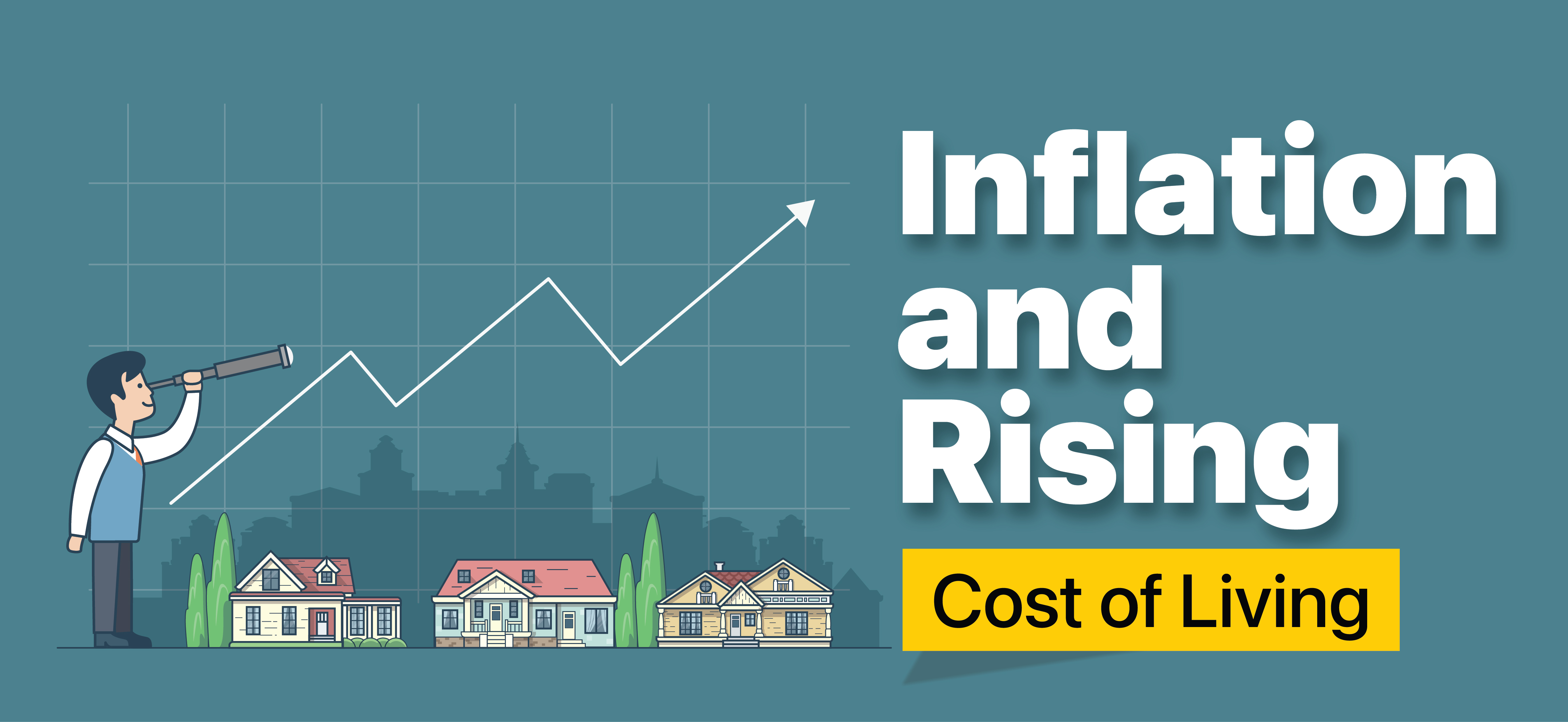Inflation and Rising Cost of Living
Blogs Home
- 01 Nov 2023

Inflation, a key economic indicator, profoundly influences India's diverse population. It is the rate at which the general price level of goods and services rises, diminishing the purchasing power of money.
As defined by the International Monetary Fund, “inflation is the rate of increase in prices over a given period of time. Inflation is typically a broad measure, such as the overall increase in prices or the increase in the cost of living in a country. But it can also be more narrowly calculated—for certain goods, such as food, or services, such as a haircut, for example. Whatever the context, inflation represents how much more expensive the relevant set of goods and/or services has become over a certain period, most commonly a year.”
In India, inflation's impact is pronounced due to economic disparities and a population numbering in the billions.
Causes of Inflation:
- Demand-pull inflation (1990s onwards): As India embraced foreign investments and urbanisation, the rise of the middle class and the IT boom elevated disposable incomes, increasing demand for real estate, automobiles, and consumer electronics. Prices surged in response to heightened demand.
- Cost-push inflation: India's reliance on oil imports results in higher fuel costs during global oil crises. These costs ripple across the economy, impacting the prices of goods and services. Citizens experience this through rising petrol and diesel prices.
- Built-in inflation: Wage hikes demanded and received by various workforce sectors can lead companies to raise prices to offset higher wage bills, creating a wage-price spiral.
- Supply chain disruptions: The agricultural sector heavily depends on monsoons. Insufficient rainfall can lead to crop shortages and increased food prices. Events like the 2020 COVID-19 pandemic disrupted supply chains, causing temporary inflationary pressures in various sectors.
In India, inflation is more than an economic statistic; it shapes the daily lives and economic sentiment of its vast population.
Consequences of Inflation
Inflation's tentacles reach deep into the everyday lives of individuals, affecting economies at both macro and micro levels. The diverse and intricate socio-economic fabric of India amplifies some of these impacts, making them more palpable for its vast population. Let's explore the consequences of inflation through the Indian lens:
1. Reduced Purchasing Power:
Inflation significantly impacts the Indian populace, especially the burgeoning middle class. Essential food items like lentils become expensive during periods of high food inflation, causing families to adjust their diets due to eroding purchasing power. This change affects even the daily wage labourers and economically marginalised individuals, making the difference between sustenance and hunger palpable.
2. Uncertainty:
Small and medium enterprises (SMEs) in India, such as those in the textile and brass industries, face instability during inflation. Reduced consumer spending leads to decreased orders, hindering investment and job creation, and even causing layoffs in some cases.
3. Financial Strain on Households:
The majority of Indian households lack inflation-adjusted incomes. When inflation surges, costs rise, putting financial strain on families. This can lead to children leaving school due to unmanageable education expenses and families forgoing essential healthcare because of rising medical costs. These situations emphasise the profound impact of inflation on Indian households.
Impact on Cost of Living:
The relationship between inflation and the cost of living is direct and profound. When inflation rears its head, the cost of living invariably follows suit. For a nation like India, with its wide socio-economic disparities, the impact can be both broad and deep. Let's break down the ramifications of inflation on the cost of living in India, drawing insights from reputable Indian sources:
1. Housing:
Inflation significantly affects the cost of housing in India. As prices for goods and services rise due to inflation, the expenses associated with housing, such as rent, mortgages, and property maintenance, also experience an upward trajectory. In major urban centers, where housing costs are already a substantial burden for many, inflation can exacerbate the affordability crisis. Low and middle-income families, in particular, find it increasingly challenging to secure affordable housing as their purchasing power diminishes in the face of rising inflation.
2. Food:
The Ministry of Consumer Affairs, Food, and Public Distribution periodically releases data on the prices of essential food commodities. Spikes in prices of staples like rice, wheat, and pulses directly influence the common man's plate. The fluctuation in onion prices, a staple in Indian cuisine, often becomes a talking point in both households and the media.
3. Transportation:
As mentioned earlier, India's heavy reliance on oil imports makes it susceptible to global crude price fluctuations. Websites like PetrolPriceToday highlight the frequent changes in fuel prices across various Indian cities. This not only affects vehicle owners but also translates into increased public transportation fares, affecting daily commuters.
4. Healthcare:
As inflation drives up the costs of medical services, hospitalisation, medication, and consultation fees, access to quality healthcare becomes progressively unaffordable for a significant portion of the population, particularly those without health insurance. The rising healthcare expenses place a substantial burden on individuals and families, often leading to financial stress and, in some cases, forcing individuals to forgo necessary medical treatment.
5. Education:
Indian Context: The rising cost of education, from primary schools to higher education, has been a concern for many Indian families. There is no specific data on the average annual private expenditure on general education in India. However, a study published in the International Journal of Creative Research Thoughts found that the average yearly educational expenses per student in households have risen significantly, going from Rs. 1149 to Rs. 6024 for primary education and from Rs. 1529 to Rs. 6866 for upper primary education between 1995-96 and 2017-18. In urban areas, parents allocate the most significant portion of their education budget to tuition and examination fees compared to rural areas. Conversely, in rural areas, more of the budget is devoted to expenses for books, stationery, and uniforms when compared to urban areas.
Strategies to Cope with Inflation: An Indian Insight
The challenge of inflation requires prudent strategies to navigate effectively. Drawing from financial resources and experts in India, here's a concise overview of coping mechanisms:
- Budgeting: Mobile banking and digital finance apps like Paytm and PhonePe offer budgeting tools. Apps like ETMONEY and Walnut help track and categorise expenditures, crucial during inflation.
- Investing wisely: The Indian stock market, NSE's Nifty, and BSE's Sensex offer investment options. Mutual funds focusing on inflation-resistant sectors and real estate in emerging hubs are smart choices. Platforms like Moneycontrol and Economic Times provide valuable insights.
- Locking in Prices: Prepaid options for mobile recharges and fixed-price schemes in the housing sector can safeguard against price hikes during inflation.
- Staying informed: Websites like Livemint, Business Standard, and CNBC-TV18 provide timely economic updates. The Reserve Bank of India (RBI) offers insights into the inflationary outlook.
- Diversifying Income Sources: Explore freelance opportunities and online platforms like Upwork and Internshala to diversify income sources during inflationary times.
- Leveraging Government Schemes: Utilise savings schemes like the Public Provident Fund (PPF), National Savings Certificate (NSC), and inflation-indexed bonds for decent returns and tax benefits.
Government Role:
Managing inflation is a complex task primarily undertaken by governments and central banks. In India, the government and RBI play pivotal roles:
- Monetary Policies: The RBI adjusts the repo rate to control inflation. Increasing the repo rate reduces liquidity, countering inflation, while lowering it boosts spending and investment.
- Cash Reserve Ratio (CRR): Adjusting the CRR keeps more funds with the RBI, reducing available money for loans and investments and curbing inflation.
- Fiscal Policies: The government revises taxation and spending to manage inflation. Reducing taxes on essentials and providing subsidies on commodities to help stabilise prices.
- Supply Chain Interventions: Schemes like Pradhan Mantri Gram Sadak Yojana improve supply chain infrastructure, ensuring goods reach markets in time, reducing wastage and price hikes.
- Strategic Reserves: The government maintains strategic reserves of essential commodities to stabilise prices in times of shortage, like food grains during poor harvests.
- Trade Policies: Depending on domestic production and prices, import and export policies are adjusted to ensure an adequate supply of commodities.
In India, these strategies and government initiatives are crucial for coping with inflation and maintaining economic stability.
Conclusion:
Inflation and the rising cost of living are inseparable companions in the dance of economics. While inflation is a natural part of most economies, understanding its causes, effects, and the tools at our disposal can help individuals, and society at large, navigate its challenges. As we tread the waters of our current economic landscape, a keen understanding of inflation becomes not just beneficial, but essential.
Sources:
https://www.imf.org/en/Publications/fandd/issues/Series/Back-to-Basics/Inflation
https://www.indiaspend.com/#google_vignette
https://www.drishtiias.com/daily-news-analysis/pradhan-mantri-gram-sadak-yojana
https://www.ijcrt.org/papers/IJCRT2012307.pdf
Shounak Roy

Shounak Roy finds pleasure in the hunt for knowledge, eagerly seeking to learn something new about anything that interests him. He describes himself as a simple and peaceful individual, always curious to delve deeper into various subjects. If he comes across someone with shared interests, he enjoys engaging in discussions and exchanging knowledge.
Blogs Home



